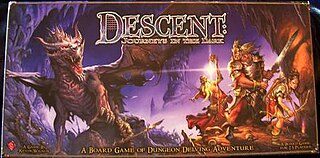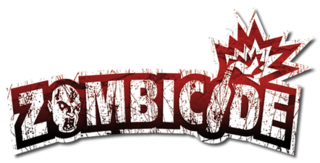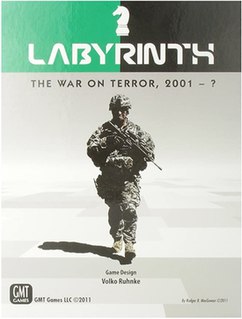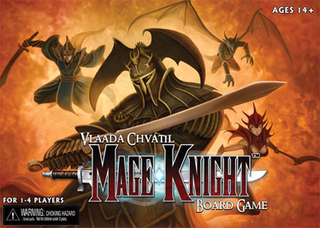
GMT Games is a California-based wargaming publisher founded in 1990. The company has become well known for graphically attractive games that range from "monster games", of many maps and counters, to quite simple games suitable for introducing new players to wargaming. They also produce card games and family games. The current management and creative team includes Tony Curtis, Rodger MacGowan, Mark Simonitch, and Andy Lewis.
Zombies!!! is a tile-based strategy board game for two to six players. Zombies!!! won the 2001 Origins Award for Best Graphic Presentation of a Board Game, and Zombies!!! 3: Mall Walkers won 2003's Origins Award for Best Board Game Expansion.
Betrayal at House on the Hill is a board game published by Avalon Hill in 2004, designed by Bruce Glassco and developed by Rob Daviau, Bill McQuillan, Mike Selinker, and Teeuwynn Woodruff. Players all begin as allies exploring a haunted house filled with dangers, traps, items, and omens. As players journey to new parts of the mansion, room tiles are chosen at random and placed on the game board; this means that the game is different each session. Eventually the "haunt" begins, with the nature and plot of this session's ghost story revealed; one player usually "betrays" the others and takes the side of the ghosts, monsters, or other enemies, while the remaining players collaborate to defeat them.

Descent: Journeys in the Dark is a two to five player high fantasy dungeon crawl published by Fantasy Flight Games in 2005. Descent was designed and produced by Kevin Wilson. The game is based on an improved version of the mechanics of FFG's licensed Doom: The Boardgame. In Descent, players take the roles of adventurers who delve into underground complexes in search of treasure. One player takes the role of the Overlord, who controls the enemies and plays cards to hinder the hero players. Descent differs from other games in the genre in that the Overlord player's goal is to win by exhausting the other players of victory points, rather than merely to facilitate play. The Overlord's resources are limited by the rules of the game, which require them to hoard and expend "threat" points, which are generated in response to the hero players' actions, in order to hamper the other players and to bring out additional monsters to defeat them. This mechanism is very much reminiscent of The Lord of the Rings when playing with the Sauron optional expansion.

Twilight Imperium is a strategy board game produced by Fantasy Flight Games. It was designed by Christian T. Petersen and was first released in 1997. The game is in its fourth edition (2017), which has large changes over previous editions. It is known for the length of its gameplay, and its in-depth strategy.

Twilight Struggle: The Cold War, 1945–1989 is a board game for two players, published by GMT Games in 2005. Players are the United States and Soviet Union contesting each other's influence on the world map by using cards that correspond to historical events. The first game designed by Ananda Gupta and Jason Matthews, they intended it to be a quick-playing alternative to more complex card-driven wargames.

Pandemic is a cooperative board game designed by Matt Leacock and first published by Z-Man Games in the United States in 2008. Pandemic is based on the premise that four diseases have broken out in the world, each threatening to wipe out a region. The game accommodates two to four players, each playing one of seven possible roles: dispatcher, medic, scientist, researcher, operations expert, contingency planner, or quarantine specialist. Through the combined effort of all the players, the goal is to discover all four cures before any of several game-losing conditions are reached.
Fields of Fire is a solitaire tactical wargame published by GMT Games that is designed to simulate various historical campaigns of wars between World War II and now. The game is card based with two decks used to play, including a terrain deck and action decks. You must build maps for missions and then use turn-based strategic actions. A single game consists of several missions from a historical campaign and each of these individual missions can be played in about 3 – 5 hours. It has won Games Magazine's award for Best New Historical Simulation Game in their 2010 Games 100 issue.

Mansions of Madness is a tabletop strategy game designed by Corey Konieczka and published by Fantasy Flight Games in 2011. Players explore a locale filled with Lovecraftian horrors and solve a mystery.

Here I Stand is a board game first published by GMT Games in 2006.

Splendor is a multiplayer card-based board game, designed by Marc André and illustrated by Pascal Quidault. It was published in 2014 by Space Cowboys, Asmodee. Players are gem merchants of the Renaissance, developing gem mines, transportation, and shops to accumulate prestige point. Spelendor received positive reviews and received numerous awards, including winner of Golden Geek Best Family Board Game, and nominated for the Spiel des Jahres Game of the Year in 2014. The game also received a mobile application and an expansion released in 2017.

Zombicide, is a collaborative adventure board game with a modern zombie theme, created by Guillotine Games. It was launched on Kickstarter by publisher CoolMiniOrNot and raised $781,597 from 5,258 backers.
Mechs vs. Minions is a 2016 cooperative board game published by Riot Games set in the League of Legends universe.

Azul is an abstract strategy board game designed by Michael Kiesling and released by Plan B Games in 2017. Based on Portuguese tiles called azulejos, in Azul players collect sets of similarly colored tiles which they place on their player board. When a row is filled, one of the tiles is moved into a square pattern on the right side of the player board, where it garners points depending on where it is placed in relation to other tiles on the board.

Terraforming Mars is a board game for 1 to 5 players designed by Jacob Fryxelius and published by FryxGames in 2016, and thereafter by 12 others, including Stronghold Games.

Labyrinth: The War on Terror, 2001–? is a board game for one or two players, published by GMT Games in 2010.

Evolution is a 2014 board game where 2-6 players build a highly competitive ecosystem of herbivores, carnivores and scavengers. Players adapt their existing species and evolve new ones in response both to the abundance or scarcity of food, but also the behaviour of other species in the ecosystem. The scoring system rewards players whose species have high populations, consume the most food and are the most diverse. It was designed by Dominic Crapuchettes of North Star Games, working with Dmitry Knorre and Sergei Machin, who had previously released a similar game in Russia.
Caverna: The Cave Farmers is a 2013 board game designed by Uwe Rosenberg. It is a complex worker placement strategy game that shares similarities in gameplay and theme with his earlier board game, Agricola, The game's theme revolves around helping a small dwarf family to settle a cave and nearby woodlands and to develop the setting through furnishing caves as well as converting forests into meadows, fields and pastures. Caverna received positive reviews from critics and ranks as one of the top games on Board Game Geek. Two major expansions have been released for the game.

Mage Knight Board Game is a cooperative board game for 1 to 4 players designed by Vlaada Chvátil and released in November 2011. It is based on the related collectable miniatures game, Mage Knight. It has been rated as one of the top single player board games.

Isle of Skye: From Chieftain to King is a tile-laying board game designed by Alexander Pfister and Andreas Pelikan that was published in 2015. It uses the Isle of Skye as its setting, with players representing clan chieftans each vying to build a kingdom.















